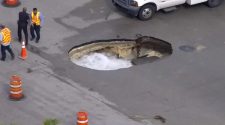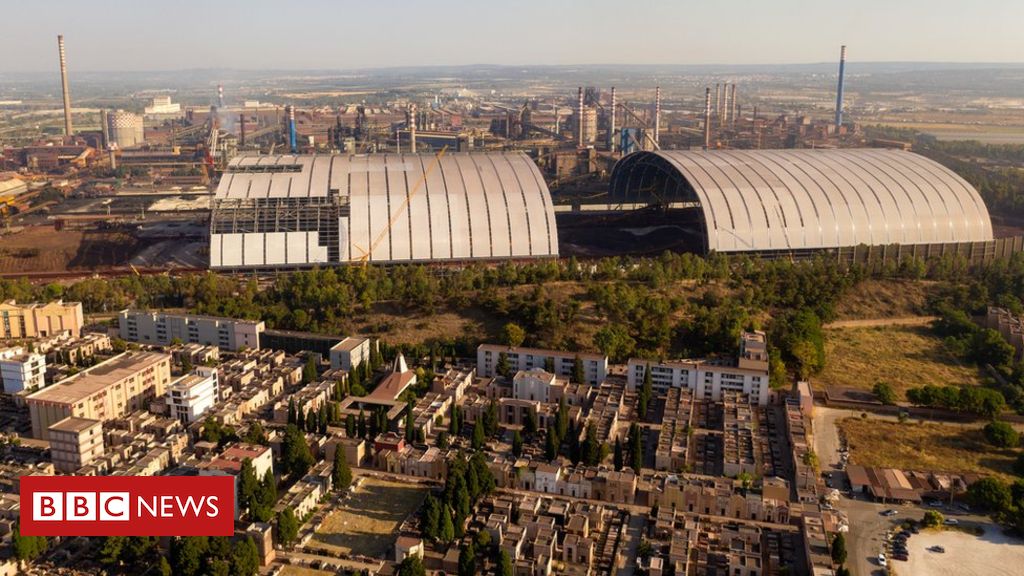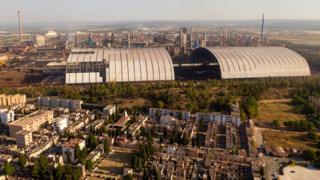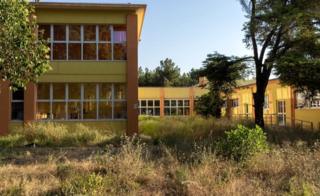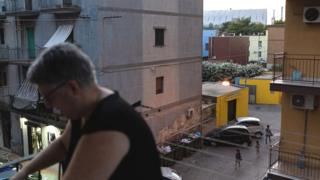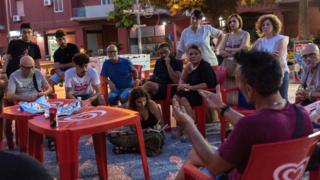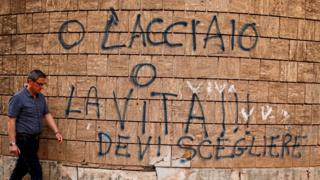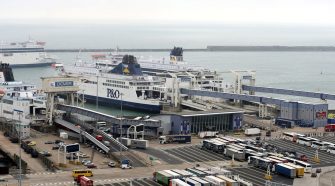Image copyright
Thomas Cristofoletti/Ruom
A cover to contain dust is being built over part of the steel factory in Taranto
A mother is cradling her baby. The mother’s eyes are loving, but her breast has morphed into a smokestack and she’s nursing her child with toxic fumes instead of nourishing milk.
That is the image portrayed in one of Carla Lucarelli’s first paintings, following the death of her son Giorgio at the age of 15.
The smokestacks, Carla explains, depict the chimneys of Ilva, the largest steel factory in Europe. It is in Taranto, a coastal city in southern Italy.
Image copyright
Thomas Cristofoletti/Ruom
Carla Lucarelli made this painting after her son died of cancer at the age of 15
“We live next to a cancer factory,” she says.
Her paintings are not just a way to channel grief, but a form of protest against the huge plant, the government that allows it to operate, and its new owner ArcelorMittal, the world’s largest steel producer.
Three years ago, Giorgio was diagnosed with a rare form of cancer. “They will never tell you that it is due to pollution,” Carla says of the doctors at the hospital. But after discovering that Giorgio grew up in Taranto, she adds, the look in their eyes “made you understand everything”.
Image copyright
Getty Images
Carla Lucarelli (L) with her partner Angelo Di Ponzo hold up a T-shirt showing their son Giorgio, who died of cancer in Taranto
Since the 1970s, scientific studies have linked emissions from the Ilva plant, which was built by the government, to health issues among the local population. One of the most recent and comprehensive reports, published by the epidemiological group Sentieri, found that between 2005 and 2012, more than 3,000 deaths were directly linked to “limited environmental exposure” to pollutants.
For some forms of cancer, Taranto’s rates were 70% higher than the regional average. Respiratory, renal and cardiovascular diseases also exceed regional averages, and children were found to be more likely to be born with disabilities.
- What does air pollution do to our bodies?
“We’re always exposed,” says Celeste Fortunato, the mother of a six-year-old boy. Their neighbourhood is right next to the plant, separated only by “ecological hills” – a supposedly natural barrier meant to shield the population from toxic dust. Last year, however, the hills were found to have been produced from the factory’s toxic waste.
Image copyright
Thomas Cristofoletti/Ruom
Two schools were forced to close due to the pollutants on the “ecological hills”
Two schools next to the ecological hills were deemed unsafe by the local mayor and closed in March, forcing 700 children to travel to schools further afield. The children had to take classes in shifts because of overcrowding.
“This last school year was really difficult for the children of the neighbourhood and their parents,” Celeste says.
The hills have since been cleaned up, according to the municipality, and the schools will be open when classes resume on Wednesday.
But many of Taranto’s parents have had enough. Carla and Celeste have helped set up grassroots groups demanding clean air for their children. They have organised marches, sit-ins, and protests, and have lobbied government officials. “What we are asking the authorities,” Celeste says, “is to shut down all sources of pollution”.
Image copyright
Thomas Cristofoletti/Ruom
Near the factory, residents keep windows shut on windy days to prevent toxic dust from entering their homes
Since 2011, the European Court of Justice (ECJ) has repeatedly ruled that the Ilva plant has been flouting environmental standards. The ECJ ordered the Italian government to act – with little success. In its most recent ruling in January, it noted the government’s failure to protect its citizens from pollution that was endangering their health.
Italian courts were also unsuccessful. In 2012, a court order to shut down the most polluting parts of the plant was overruled by the government in Rome. In a poverty-stricken region 20,000 jobs depended on Ilva, and losing your job, the health minister said at the time, would also have a detrimental impact on an individual’s health.
Image copyright
Thomas Cristofoletti/Ruom
Community groups meet in the Tamburi neighbourhood of Taranto to discuss the closure of two schools
Local officials agree that more should be done to protect the local population, but they say that the mayor does not have the power to close Ilva. The best they can hope for, the city says, are improvements to the factory.
- A unique way to beat air pollution
That’s what ArcelorMittal has pledged. When the Luxembourg-based group took over the plant last November, it earmarked €1.2bn (£1bn; $1.3bn) for an environmental plan to cut emissions to zero, according to Henri-Pierre Orsoni, the company’s head of engineering.
“The target is excellence,” Mr Orsoni says, explaining that due to the plant’s proximity to the city, it should adhere to higher environmental standards than other factories.
The Italian government promised ArcelorMittal when it purchased the plant that it would not be held accountable for any environmental damage or health impacts while implementing its clean-up measures.
In June, parliament agreed to revoke this guarantee – but the move was not ratified. Italy’s new minister for economic development, Stefano Patuanelli, said this month that he was prepared to give ArcelorMittal the guarantees it needed to continue operating the plant during the process.
Image copyright
Reuters
A statement written on a wall in Taranto reads: “Steel or life, you have to choose.”
Shutting down operations while the clean-up takes place, Mr Orsoni says, is not an option. “In this kind of factory, you have a lot of equipment that is working 24 hours. If you stop it, you destroy the plant”.
While cutting emissions by upgrading stacks, the biggest visible change will be covers for open-air mineral storage sites. For decades, northern winds have picked up dust from these sites and spread it across the city, leaving red stains on buildings and laundry.
The main dome – a large steel structure that will cover an area the size of 23 football pitches and weigh about twice as much as the Eiffel Tower – is scheduled to be completed in November. By 2023, Mr Orsoni says, the entire environmental plan will be completed.
Taranto’s parents say they fear it is too little too late.
While still defiant, Celeste says she does not believe that Ilva will ever close, and that improvements are the best they can hope for. “The economic interests,” she says, “are more important than our lives”.
All photos are subject to copyright.


